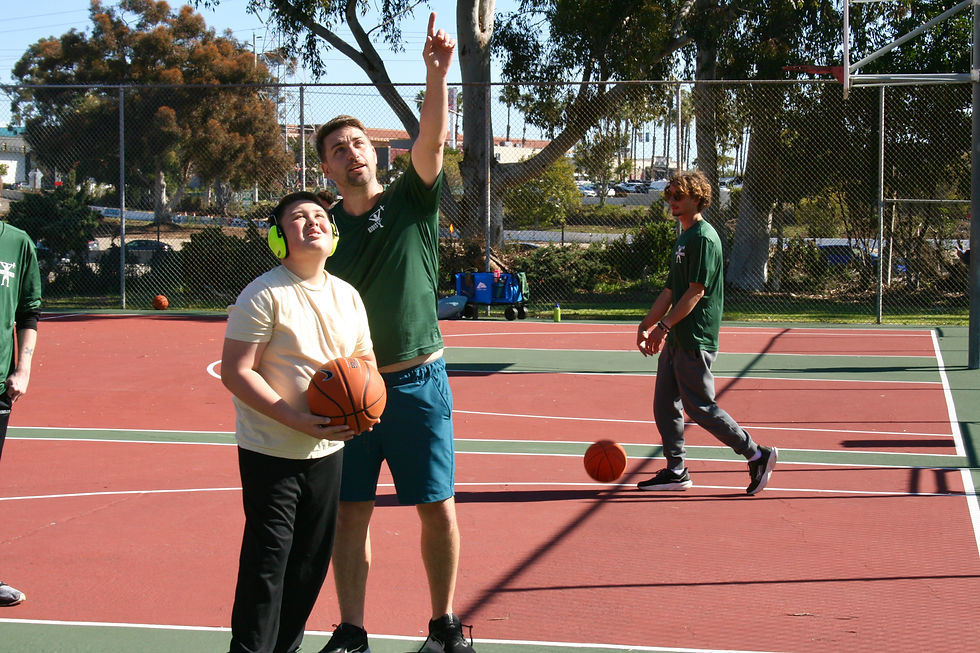Benefits of Fitness for Individuals with Autism
- Ryan Bigelow
- Apr 1
- 4 min read

When you engage in a workout, your breathing deepens, and your heart rate rises—delivering a surge of oxygen and nutrients throughout your body and to your brain. This increased circulation fuels cognitive function and triggers the release of powerful neurotransmitters like dopamine and endorphins. Commonly known as the brain’s “feel-good” chemicals, these neurotransmitters promote the sense of relaxation, clarity, and accomplishment you may feel following physical activity.
Dopamine not only elevates mood and motivation, but also plays a vital role in motor control, helping coordinate smooth and intentional movement. Endorphins, meanwhile, help reduce stress and anxiety, fostering a calming effect. For individuals with autism, these neurochemical responses offer far more than just a post-workout boost—they serve as key tools for improving emotional regulation, motor development, and overall well-being.
Nearly 80% of individuals with autism experience some form of motor control difficulty. At the same time, children with autism are 58% more likely to develop obesity than their neurotypical peers–a disparity influenced by factors like atypical eating habits, limited physical activity, sleep challenges, and certain medications. These statistics highlight the vital need for movement-based interventions tailored to the autism community.
According to studies published in Frontiers in Psychiatry, regular exercise has been shown to significantly reduce a range of challenges commonly associated with autism, including difficulties with social interaction, attention, emotional regulation, motor coordination, verbal expression, and even sleep disturbances. Positive behavioral changes, including reduced repetitive behaviors, further reinforce the idea of fitness-based interventions as an effective resource for individuals with ASD.
At Kidisthenics, we go beyond traditional exercise by incorporating evidence-based movement methodologies into every session. Our approach blends primitive movement training, rhythmic movement training (RMT), and Masgutova Neurosensorimotor Reflex Integration (MNRI) into outdoor, sensory-rich experiences designed to unlock the body’s full potential. Together, these practices support physical growth, cognitive development, and emotional resilience.
Primitive and Rhythmic Movement: Rewiring the Brain
Primitive movement training focuses on the natural, foundational movements humans demonstrate early in life—such as crawling, climbing, rolling, and jumping. For individuals with ASD, these exercises are especially beneficial as they target retained primitive reflexes—involuntary movements that linger beyond infancy due to delays in nervous system maturation. These reflexes often interfere with motor skills and cognitive processing. By revisiting and reinforcing these basic movement patterns, primitive movement training helps rewire the brain, promoting smoother communication between the brain and body and enabling more purposeful movement.
When paired with rhythmic movement training—which emphasizes repetitive, fluid motions—these exercises help regulate the nervous system, strengthen neural pathways, and reduce anxiety and stress levels. This combination creates an ideal foundation for individuals with autism to build better motor coordination and improve emotional stability.
Releasing to Regulate: The Role of MNRI and Proprioceptive Input
The most essential element to priming an individual with autism’s nervous system to engage in high-intensity movement is to release excess energy and anxiety first. This is where MNRI comes into play.
At Kidisthenics, we introduce clients to “energy-release movements”—a targeted resistance band sequence designed to stimulate areas of tension in the body. This practice supports proprioceptive regulation, which is often disrupted in individuals with autism.
Proprioception is the body’s sense of its position in space. Individuals with autism frequently experience either hypersensitivity or hyposensitivity to proprioceptive input. For some, certain movements or sensations may feel overwhelming and trigger agitation. For others, under-sensitivity can lead to a constant craving for intense, repetitive motion or pressure.
By providing controlled proprioceptive input, Kidisthenics helps clients regulate these responses. For those with oversensitivity, gentle resistance movements like chest pulls and overhead stretches offer calming input without overwhelming the senses. Deep pressure techniques—such as stretching a band around the body in repeated motions to simulate a firm hug—help ground the individual, reduce anxiety, and promote a sense of calmness.
For those who are under-sensitive, more intense movements can help meet their sensory needs and build greater body awareness. By stimulating key sensory systems, these techniques support improved focus, emotional regulation, and motor coordination—paving the way for meaningful growth in and outside of sessions.
Once our clients have completed their primitive movement sequences and energy-release band exercises, their bodies—and more specifically, their vestibular systems—are primed and ready to take on the challenges of high-intensity movement.
Expanding Comfortability in Movement
The vestibular system, located in the inner ear and deeply connected to the brain, is responsible for detecting motion, balance, spatial orientation, and coordination. For individuals with autism, dysfunction in this system can lead to challenges such as poor balance, difficulty with posture, and even a fear of everyday movement. Some individuals may avoid activities like climbing or walking on uneven surfaces due to hypersensitivity, while others may seek intense movement, such as spinning or jumping, due to hyposensitivity. Left unaddressed, these behaviors can impact daily life and independence.
The most effective way to support and strengthen the vestibular system is through structured, intentional movement. Our high-intensity programs—like basketball, kayaking, and football—are not just fun or physically engaging; they are carefully designed to activate and challenge the vestibular system in a safe, supported environment. With each session, clients build coordination, spatial awareness, and confidence in their ability to move through the world.
At Kidisthenics, we understand that every individual with autism has unique needs. That’s why our movement specialists work closely with parents and caregivers to identify sensory triggers and tailor activities accordingly. This ensures that every client experiences physical activity in a way that feels safe, empowering, and enjoyable. Through repetition, support, and consistent progression, our clients begin to regulate their responses to movement more effectively—reducing fear, increasing confidence, and gaining greater independence in their day-to-day lives.
When the vestibular system is consistently engaged through physical activity, it doesn’t just improve balance or coordination—it opens the door to a fuller, more active life. Fitness is more than movement—it’s the foundation for lasting growth, confidence, and independence in individuals with autism.
Comments